Stainless Steel Catalogue – Types & Grades Explained
Stainless Steel Types and Grades from Austral Wright Metals
Austral Wright Metals has a history of over 75 years in the stainless steel sheet, plate and coil business as one of the industry’s leading suppliers.
Our Australian national and state warehouses carry a wide range of standard and non-standard stock sizes of various stainless steel grades and are fully equipped to supply the unique needs of Australia’s major manufacturers of products such as sinks, white goods and automotive components. Technical expertise together with our association with the worlds’ leading Asian and European mills allow us to continue to satisfy the most stringent needs of today’s quality conscious and competitive markets.
Download Our Stainless Steel Product Catalogue

Find out how fast we could deliver to your facility, what prices we can offer or let us help you choose the right product for you.
Table of Contents
Section 1 – Stainless Steel

Types of Stainless Steel
Stainless steels are steel alloys that contain more than 10.5% chromium with excellent corrosion resistance. Chromium reacts strongly with oxygen to form a very thin, invisible, stable oxide film on the surface of the stainless steel. This film is called the passive layer and forms rapidly in ordinary atmospheres. If it is damaged, the film usually heals spontaneously. It is this passive layer that gives stainless steel its corrosion resistance.
There are many different stainless steels, with different amounts of alloying elements added to give the best balance of corrosion resistance, mechanical properties and cost. Although straightforward for most applications, choosing the optimum grade of stainless steel can sometimes be complex, and Austral Wright Metals engineers and metallurgists will be pleased to provide assistance.
The stainless steels can be divided into five groups – austenitic, ferritic, duplex, martensitic and precipitation hardening. Each group has different dominant characteristics, and there are several grades within each group.
Austenitic Grades of Stainless Steel
Austenitic stainless steels are easy to work and weld, and have excellent ductility, toughness and corrosion resistance with good strength. They contain 17 to 25% chromium and 8 to 20% nickel, and may contain other elements to achieve the desired properties. The most common extra element is molybdenum, which greatly improves corrosion resistance. Austenitic stainless steels are usually used in the annealed condition, when they have a useful range of mechanical and physical properties. Strength can be increased by cold working, but not by heat treatment. Welding of this stainless steel grade is straightforward, although welding procedures are a little different to those used for carbon steel. Austenitic stainless steels are non-magnetic in the annealed condition, but will become slightly magnetic when cold worked.
304
304 Grade 304 is the most widely used stainless steel with good resistance to atmospheric corrosion and to many organic and inorganic chemicals. This grage has excellent workability, weldability and impact strength. It is sometimes known as 18/8 stainless steel, since it contains 18% chromium and 8% nickel. It is suitable for use in a variety of applications, in fact it is the most common stainless steel, and about 60% of all stainless steel used in the world is grade 304.
304L
304L Grade 304L is a low carbon (<0.030%) variant of 304 with the same corrosion resistance, but with less susceptibility to sensitisation when welded at thicknesses of 4 mm or greater, or after heat treatment. Sensitisation can allow intergranular corrosion to occur. Grade 304L is used in parts of 4mm and thicker which will be welded but not post weld annealed. Parts made from this grade are generally limited to service at temperatures up to 425ºC. The physical properties and thermal treatments are similar to those of grade 304.
316
Stainless Steel 316, or Grade 316, is known as the marine alloy. The corrosion resistance is improved by an addition of 2 to 3% of molybdenum, as well as 18% chromium and 10% nickel. Grade 316 has better corrosion resistance than grade 304 in many chemicals as well as in marine atmospheres. Grade 316 also has applications in the chemical, textile and paper industries. It has similar strength to grade 304, and gives better performance in deep drawing.
316L
316L Grade 316L is a low carbon (<0.030%) variant of 316 with the same corrosion resistance, but with less susceptibility to sensitisation when welded at thicknesses of 4 mm or greater, or after heat treatment. Sensitisation can allow intergranular corrosion to occur. Grade 316L is used in parts of 4mm and thicker which will be welded but not post weld annealed. Parts made from this type are generally limited to service at temperatures up to 425ºC. The physical properties and thermal treatments are similar to those of grade 316.
303
Grade 303 was developed to improve the machinability of grade 304. It is used where production involves extensive machining in automatic screw machines. It contains 18% chromium and 8% nickel. Sulphur or selenium is added to give excellent free machining and nonseizing properties. The addition of sulphur or selenium lowers corrosion resistance and grade 303 should not be used in water. Grade 303 is non hardenable and not recommended for welding. Austral Wright Metals standard stock of round bar in grades 304 and 316 has a controlled addition of calcium to improve machinability, and grade 303 is used less nowadays.
253
253 MA® Grade 253MA® is used at high temperatures. It has excellent resistance to oxidation and excellent strength at elevated temperatures. This grade has very good high temperature corrosion and erosion resistance in most environments. It also has good formability and weldability properties. Most suitable temperature range is 850-1100ºC (standard grade 304 is qualified for pressure applications up to 800ºC). 253MA® contains about 22% chromium, 11% nickel and 0.09% carbon, with about 0.05% of the rare earth metal cerium added to improve the protective ability of the oxide.
Ferritic Grades
Ferritic stainless steels have similar strength, ductility and fabrication characteristics to carbon steels, with much better corrosion resistance. This group contains grades with 10.5% up to 22% chromium, which do not have the nickel addition made to austenitic grades. The amount of chromium controls the corrosion resistance, and there are some special grades where there is an extra addition of molybdenum. The limitation of the ferritic grades is that welds in some grades lack toughness, and they are rarely used in structural applications – hence they are mainly available as sheet and coil up to about 1.6 mm in thickness. Ferritic grades canot be strengthened by heat treatment, and are not much strengthened by cold work, so they are usually used in the annealed condition. All the ferritic grades are magnetic in all conditions.
409 Grade 409 is a utility grade of stainless steel containing about 10.5% of chromium. It is mainly used in automotive exhaust systems, and other applications where appearance is not important. The surface soon stains, but the rate of metal loss is much lower than with carbon steel.
430 Grade 430 is the most common ferritic stainless steel, used for mild indoor environments, dishwasher liners and automotive trim. It contains 17% of chromium, and hence the corrosion resistance is a little less than that of grade 304. In architectural applications it is usually only used indoors.
Duplex and Super Duplex Grades
This group of stainless steels typically consists of equal parts of austenite and ferrite. This group has 18 to 29% chromium, 3 to 8% nickel and various other elements, particularly molybdenum and nitrogen. The duplexes offer advantages over austenitic grades. They are strong, with twice or more the yield strength of the common austenitic grades, and are highly resistant to chloride stress corrosion cracking. The higher alloyed grades have excellent resistance to pitting and crevice corrosion in many environments. The duplex grades are not heat treatable and have a low response to cold work, so are used in the annealed condition. They are easy to weld and fabricate, although not as easy as the austenitic grades. The duplex grades are magnetic in all conditions.
2205 Grade 2205 is a duplex stainless steel containing 22% chromium, 5% nickel and 3% molybdenum. The high alloy content gives it superior resistance to pitting and crevice corrosion, and the duplex structure gives excellent resistance to stress corrosion cracking. The grade has high strength. The steel is well-suited for high chloride environments. Applications include heat exchangers, chemical tankers, chemical reactor vessels, flue gas filters, acetic acid distillation, oil and gas industry equipment.
S32750 Grade S32750 is a super duplex stainless steel containing 25% chromium, 7% nickel and 4% molybdenum. It has the highest resistance to pitting and crevice corrosion of the duplex grades, with high resistance to stress corrosion cracking and very high strength. Applications include oil and gas industries, off-shore, petrochemical plants, desalination plants and mechanical and structural components demanding high strength combined with high corrosion resistance.
Martensitic Grades
This group contains 12% to 16% chromium and 0.08% to 2.00% carbon. The high carbon content makes the martensitic grades respond well to heat treatment to give high mechanical strength and hardness. However, the carbon is detrimental when welding and these grades are difficult to weld. The ductility of these grades is limited and they are not cold worked. In the heat treated condition, this group of stainless steels show a useful combination of corrosion resistance and mechanical properties that qualify them for a wide range of application. The martensitic grades are magnetic in all conditions.
410 Grade 410 is the general purpose corrosion and heat resisting stainless steel. It contains 12.5% chromium and can be used in mildly corrosive environments. It is the most inexpensive corrosion resistant steel for general purposes, but is not suitable under severe corrosion conditions. Frequently used for stainless steel cutlery, furnace parts, bolts, bushings, and uses requiring high strength and wear resistance such as chutes, screens and mineral processing equipment.
420C Grade 420C also has 12.5% chromium, with a higher carbon content than 410 (0.25%) to increase hardness to a maximum of approximately 500 Brinell (50 HRC). It has optimum corrosion resisting qualities when hardened and tempered. Used for springs, shafts, valves.
431 Grade 431 is a 16% chromium martensitic stainless steel with a small (2%) addition of nickel. It can be heat treated to the highest mechanical properties, and is mainly used for fasteners and shafts. Its corrosion resistance is superior to that of grades 410 and 420C.
Precipitation Hardening Grades
This group contains 12% to 16% chromium and 3 to 9% nickel, with small additions of precipitate forming elements such as aluminium, copper, niobium and titanium. They are designed to be heat treatable to very high strength, with better ductility than the martensitic grades. They are usually machined and fabricated in the soft, solution annealed condition, then tempered up to the required combination of strength, ductility and toughness. Because the chromium content is limited, most of the precipitation hardening grades have similar corrosion resistance to 304. Most applications are in the aerospace and other high-technology industries, and in boat shafting.


New Generation Stainless Steels
General Purpose Ferritic Grade AWM404GP® Stainless Steel
Available exclusively from Austral Wright Metals
New generation general-purpose ferritic grade AWM 404GP® can be used to replace the workhorse austenitic grade 304 in most applications. It is a corrosion resistant ferritic stainless steel with excellent strength, toughness, fabrication characteristics and weldability. The general corrosion resistance of AWM 404GP® is at least as good as grade 304, with better resistance to atmospheric corrosion, stress corrosion cracking and sensitization to intergranular corrosion.
Grade AWM 404GP® compared to grade 304
|
|
|
Typical Applications
Benchwork, cold-water tanks, whitegoods, refrigeration cabinets, chemical and food processing, water treatment plant, street furniture, electrical cabinets. AWM 404GP® can be substituted for 304 in most applications except structures and pressure vessels.
Description
Grade AWM 404GP® contains 21% of chromium and 0.5% of copper, which give it excellent resistance to corrosion in many environments. AWM 404GP® has at least the corrosion resistance of grade 304, and is increasingly replacing 304 in sheet metal applications. Many users of AWM 404GP® make significant savings from the ease of fabrication – ferritic grades give less tool & machine wear than 304. Better quality products, with crisper, neater bends are achievable with AWM 404GP®. AWM 404GP® is magnetic, which does not affect the excellent corrosion resistance given by the high chromium content. Thermal expansion is lower, so there is less thermal distortion of panels in fabrication and in service.
Availability
Austral Wright Metals stock this grade as sheet and coil in thicknesses 0.55, 0.7, 0.9, 1.2, 1.5 and 2.0 mm, all 1219 mm wide. 914 mm wide is available in some thicknesses. 2B and No 4 finish. The finishes are brighter than for 304 – ferritic grades have a brighter surface finish than austenitic grades. The 2B finish may be variable across the width and should not be used where this is unacceptable.
Toughness
AWM 404GP® has the same ferritic microstructure as carbon steel, so undergoes a ductile-to-brittle fracture mode transition at low temperatures. AWM 404GP® is tough in the welded condition down to 0ºC, and can be used for non-structural purposes at lower temperatures.
Pressure Vessels
AWM 404GP® can be used for pressure vessels at elevated temperatures, but it is not pre-qualified in pressure vessel codes.
Heat Treatment
AWM 404GP® is not hardenable by heat treatment. Heat treatment is rarely required in sheet metal applications, but AWM 404GP® can be annealed at 820 – 900ºC, rapid air cool.
Corrosion Resistance
The chemical composition of AWM 404GP® gives it a higher Pitting Resistance Equivalent (PRE) than 304, which indicates at least equivalent pitting corrosion resistance. Pitting is the form of corrosion stainless steels are often least resistant to. Laboratory tests and service experience have not identified circumstances in which the corrosion resistance of AWM 404GP® is inferior to 304, except pitting propagation rates, which are 3 – 4 times faster. Unfortunately, once initiated, pitting corrosion propagation is rapid for both grades, and practical selection of stainless steels aims to avoid pitting corrosion rather than achieve low propagation rates.
Resistance to the initiation of pitting corrosion in artificial seawater at 30ºC. Shows equivalent resistance to pitting corrosion initiation for the general purpose grades 304 and AWM 404GP®

Stainless Steel Atmospheric Corrosion – Actual Exposure Test
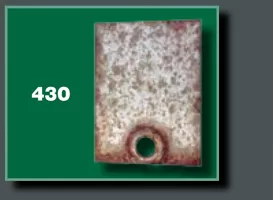

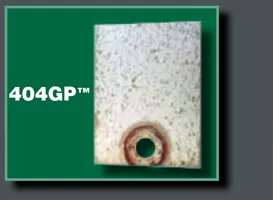
Test Conditions: Marine Industrial atmosphere at Chiba, Tokyo, Japan (10m from a bay bigger than Melbourne Bay)
Samples polished to #600 grit. Exposed for 12 months. Note: these grades would not normally be specified for these aggressive conditions, which require 316 or 445M2.
As a ferritic grade, AWM 404GP® does not stress corrosion crack in drinking water, unlike 304 which may stress corrosion crack above about 50ºC. The titanium in AWM 404GP® prevents sensitization to intergranular corrosion by welding.
High Temperature Service
The high chromium content of AWM 404GP® gives excellent oxidation and sulphidation resistance, and similar grades are used extensively in automotive muffler systems. AWM 404GP® can be used in air up to 980ºC for continuous service, 1035ºC for intermittent service. The strength of ferritic grades above about 600ºC is generally less than that of austenitic grades. Where later ambient temperature toughness and corrosion resistance are important, the service temperature should be restricted to 400ºC to avoid precipitation reactions.
Cleanability
AWM 404GP® is excellent for food equipment, where cleanability for the removal of bacteria is vital. AWM 404GP® resists corrosion by food and cleaning chemicals, and harbours very low levels of bacteria after cleaning.
Fabrication and Formability As a ferritic stainless steel, AWM 404GP® behaves like carbon steel (G300). Bends are neater, with low springback and forming loads. Wear on cutting and forming tools is typically 3 – 5 times better. Cutting tool clearances are similar to carbon steel. The minimum radius for bending is 1t. Deep drawability is better than 304, but stretch capability is lower. Please consult Austral Wright Metals for deep drawing applications.
Machinability
AWM 404GP® is easier than 304 to machine due to lower work hardening rate and better thermal properties. Cleaner cuts and flatter panels are obtained, with better cutting tool life.
Weldability
AWM 404GP® can be welded by the common methods (TIG, MIG, spot, seam), without preheat, post heat or post weld heat treatment. Heat input needs to be 10 – 30% higher than for grade 316 as heat is conducted away from the weld pool more quickly by AWM 404GP®. Manual Metal Arc welding (MMAW or stick welding) is not recommended – AWM 404GP® is used in light gauges, not easy to stick weld. AWM 404GP® can be TIG welded without filler metal, or with 308L(Si) or 309L(Si) filler metal. Avoid introducing carbon into the weld by degreasing before welding – degreasing is as important with AWM 404GP® as it is with aluminium. Gas shielding must be excellent – use argon, or argon plus helium or up to 3% CO2. Never use nitrogen or hydrogen in welding or backing gases. For best pickling after welding, ensure oxidation is minimised and use the pickling paste for longer than with 304. Portable electroplating equipment is very effective in removing residual oxide colour.
New Generation Stainless Steels
Ferritic Marine Grade 445M2 Stainless Steel
Available exclusively from Austral Wright Metals
New generation ferritic marine grade 445M2 can be used to replace the traditional marine grade 316 in most applications. It is a ferritic, corrosion resistant steel with excellent strength, toughness, fabrication characteristics and weldability. The general corrosion resistance of 445M2 is at least as good as grade 316, with better resistance to atmospheric corrosion, stress corrosion cracking and sensitization to intergranular corrosion.
Grade 445M2 compared to grade 316
|
|
|
Typical Applications
Roofing, walling, awnings and fascias, hot water tanks, drums, barrels, heat exchangers, chemical and food processing, water treatment plant, chemical processing equipment, architectural and boat fittings exposed to marine and polluted atmospheres, street furniture, electrical cabinets, freezer trays.
Description
Grade 445M2 contains 22% of chromium and over 1% of molybdenum, which give it excellent resistance to corrosion in most environments. 445M2 has at least the corrosion resistance of grade 316, and is increasingly replacing 316 in sheet metal applications. Many users of 445M2 make significant savings from the ease of fabrication of 445M2, which is ferritic and gives less tool & machine wear than 316. Better quality products, with crisper, neater bends and less thermal distortion of panels are also achievable with 445M2.
Availability
Austral Wright Metals stock this grade as sheet and coil in thicknesses 0.55, 0.7, 0.9, 1.2, 1.5, 1.6, 2.0, 2.5 and 3.0 mm, all 1219 mm wide. 2B and No 4 finish. 0.55 x 940 mm with a low gloss 2DR finish is also stocked for architectural applications. Note the finishes are brighter (2DR excepted) than for 316 – ferritic grades have a brighter surface finish than austenitic grades.
Toughness
Grade 445M2 has the same ferritic microstructure as carbon steel, so undergoes a ductile-to-brittle fracture mode transition at low temperatures. 445M2 is tough in the welded condition down to 0ºC, and can be used for non-structural purposes at lower temperatures.
Pressure Vessels
Grade 445M2 has been used for pressure vessels used at elevated temperatures, but it is not pre-qualified in pressure vessel codes.
Heat Treatment
445M2 is not hardenable by heat treatment. Heat treatment is rarely required in sheet metal applications. 445M2 can be annealed at 820 – 900ºC, rapid air cool.
Corrosion Resistance
The chemical composition of 445M2 gives it a similar, but typically higher Pitting Resistance Equivalent (PRE) than 316, which indicates at least equivalent pitting corrosion resistance. Laboratory tests and service experience have not identified circumstances in which the corrosion resistance is inferior to 316, except pitting propagation rates, which are 3 – 4 times faster. Pitting corrosion propagation is rapid for both grades, and selection of stainless steel grades aims to avoid pitting corrosion rather than achieve low propagation rates.
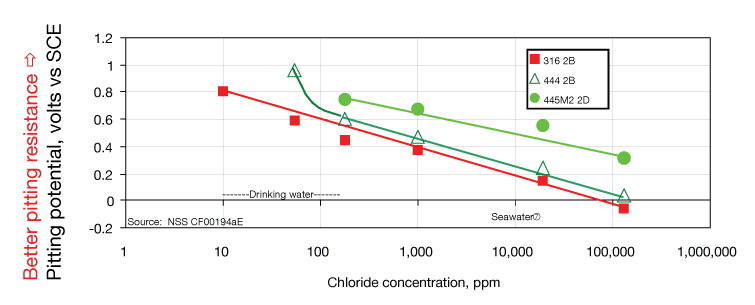
This graph shows the results of results of pitting corrosion tests in water at a range of chloride contents at 80ºC. Higher volts indicate greater resistance to pitting initiation. The advantage of 445M2 over 316 is about the same as the advantage of 316 over 304. 444 is from the previous generation of ferritic grades. 445M2 will resist pitting corrosion in drinking water up to about 1,000ppm of chloride at room temperature, 200ppm at 100ºC.
New generation ferritic stainless steels like 445M2 resist atmospheric corrosion better than austenitic or duplex grades of the same PRE, particularly with regard to rust area (i.e. tea staining) and gloss retention. This figure compares new generation ferritic stainless steels with austenitic grades and a duplex after three years exposure in a marine industrial atmosphere.


Source: Y.Yazawa et al, International Congress Stainless Steels 96, Dusseldorf.
As a ferritic grade, 445M2 does not undergo stress corrosion cracking in drinking water, unlike 316 which may stress corrosion crack above about 50ºC. 445M2 has additions of titanium and niobium, which prevent sensitization to intergranular corrosion when welded.
High-Temperature Service
The high chromium content of 445M2 gives excellent oxidation resistance, and similar grades are used extensively in automotive muffler systems. 445M2 can be used in air up to 980ºC for continuous service, 1035ºC for intermittent service. The high temperature strength of ferritic grades is generally less than that of austenitic grades. Where later ambient temperature toughness and corrosion resistance are important, the service temperature should be restricted to 400ºC to avoid precipitation reactions.
Cleanability
445M2 is excellent for food equipment, where cleanability for the removal of bacteria is vital. 445M2 resists corrosion by cleaning chemicals, and harbours very low levels of bacteria.
Fabrication
As a ferritic stainless steel, 445M2 behaves like carbon steel (G300). It gives neat bends with low springback, low forming loads and exceptionally low wear on cutting and forming tools – typically 3 – 5 times better life. Cutting tool clearances are similar to carbon steel.
Machinability
445M2 is easier than 316 to machine due to lower work hardening rate and better thermal properties. Cleaner cuts and flatter panels are obtained, with better cutting tool life.
Weldability
445M2 can be welded by the common methods (TIG, MIG, spot, seam), without preheat, post heat or post weld heat treatment. Heat input needs to be 10 – 30% higher than for grade 316 as heat is conducted away from the weld pool more quickly by 445M2. Manual Metal Arc welding (MMAW or stick welding) is not recommended – 445M2 is used in light gauges, not easy to stick weld. 445M2 can be TIG welded without filler metal, or with 316L(Si) filler metal. Gas shielding must be excellent – use argon, or argon plus helium or up to 3% CO2. Never use nitrogen or hydrogen in welding or backing gases. For best pickling after welding, ensure oxidation is minimised and leave the pickling paste on the weld for 50% longer than with 316. Portable electroplating equipment is very effective in removing residual oxide colour.
Popular Myths about Stainless Steel
“All Stainless Steel is the same”
Actually, stainless steels are a family of alloys, which can have a great range of properties, depending on what they are to be used for. Stainless steels are often used for their appearance or corrosion resistance, but they are also used for heat resistance, strength or toughness, and for their magnetic properties. The best grade of stainless is chosen to suit the application. The grades fit into branches of the family, called austenitic, ferritic, duplex, martensitic or precipitation hardening, depending on their crystal structure.
“Stainless Steel doesn’t rust”
Strictly speaking, stainless doesn’t rust. Some industry publications even say it can’t. But like all materials, there are some environments which are just too corrosive and it will be attacked – after all, even gold will dissolve in aqua regia, a potent mixture of nitric and hydrochloric acids. And sometimes, when stainless is attacked, the corrosion product looks just like the rust you get on carbon steel.
Stainless steel resists corrosion better than most other metals because of a very thin, colourless passive layer that forms spontaneously on the surface.When the passive layer is breached, it usually forms again spontaneously. In aggressive environments, such as very close to the beach, where there is a lot of salt in the air, the passive layer may not be able to form, and some corrosion may take place. Although the stainless steel may look ‘rusty’, it will corrode so much more slowly than most other metals that it will still be serviceable long after any other common engineering metal.
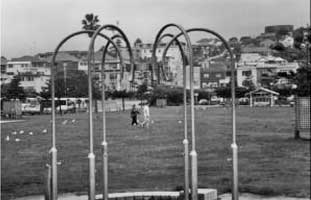
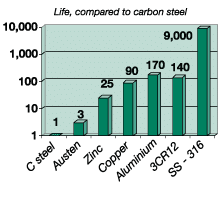
The graph above shows the results of a 20 year corrosion study from a very corrosive environment near a beach in South Africa: an even more severe environment than the most aggressive in Australia, such as Newcastle Beach.
Stainless steel grade 316 gave about 9,000 times the life of carbon steel. Grade 304 would be similar, although not quite as much. And this in an environment where each millimetre of carbon steel would corrode away completely in about four years.
Of course, the passive layer that stainless steel relies on for protection has to be allowed to form. Blue and black visible oxides formed during heat treating, welding and heavy grinding interfere with the formation of the passive layer. They must be removed to get the full corrosion resistance of each grade of stainless steel.
Often, when stainless steel appears to be rusting, it has actually been contaminated with carbon steel – which rusts, of course! And the stainless steel gets the blame. The secret is to fabricate the stainless steel in a dedicated area and make sure there is no contamination with carbon steel from tools, equipment and storage fixtures. And if there is carbon steel contamination, treat the stainless with a passivating acid to remove it.
“Stainless Steel is not magnetic”
Some types of stainless steel, including the most common ones, the austenitics, aren’t magnetic. But most types – the ferritics, martensitics, duplexes and most of the precipitation hardening grades – are magnetic. The corrosion resistance is not affected in any way by whether the grade of stainless is magnetic or not – corrosion resistance depends on how much of the key alloying elements you have, especially chromium and molybdenum.
Even the austenitics can become somewhat magnetic when they are deformed. Try putting a magnet in the corner of a stainless steel sink – some magnetism can usually be detected. The amazing ability of austenitic stainless steel to deform without breaking is used to deep draw sinks in one piece – without heating!
“Stainless Steel is expensive”
Stainless steels do cost more than carbon steels, in dollars per tonne. With the extra alloys, they are bound to. But the extra performance of stainless steels more than pays for the difference, and stainless often works out as the cheapest way to do the job. Carbon steel usually needs to be painted for corrosion protection, and even if their first installed cost is lowest, their advantage disappears on the day they have to be repainted. The cost of stainless in dollars per day for the life of the job will be much lower.
“18/10 Stainless Steel is better than 18/8 Stainless Steel”
Actually they are both the same. The common austenitic grades contain about 18 to 20% of chromium, and 8 to 10% of nickel. Europeans often refer to them as 18/10 stainless, while the English speaking world – Australia, USA, UK – call them 18/8 stainless. There are minor differences between the standard stainless steel compositions in different parts of the world, but the performance of the grades are effectively the same wherever in the world they are made.
“All Stainless Steels have the same corrosion resistance”
The corrosion resistance of stainless steels mostly depends on their content of the alloying elements chromium and molybdenum, plus a few other factors, depending on the specific application. The surface finish and fabrication practice can have a major effect.
PDF Downloads


